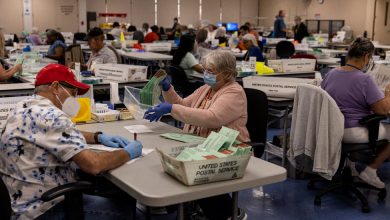Democrats Failed to Extend Assault Weapons Ban in 2004. They Regret It.

WASHINGTON — In late 1993, Democrats were on the cusp of a legislative triumph that seems inconceivable in today’s polarized debate over gun control: They were about to outlaw an entire class of firearms — semiautomatic assault rifles — as part of a big bipartisan crime bill.
But to win over moderates in both parties, they made a pair of concessions that to proponents seemed relatively modest, exempting more than 2,200 firearms from the list of prohibited weapons and requiring that the ban be renewed in 10 years.
The crime bill passed, with great fanfare, in 1994.
The assault weapons ban lapsed, with little fuss or fight, in 2004.
That the ban — a central policy goal of Democrats after a spate of mass shootings in recent weeks — was allowed to expire so quietly, without the party mounting a major effort to preserve its most consequential gun control achievement in decades, is increasingly a matter of puzzlement and outrage.
“You look around today, and there’s this incredible sense of urgency after Buffalo and Uvalde, but back in 2004, there was no enthusiasm to renew the ban among Democrats — none,” said Brian Malte, a former top official for the Brady Campaign to Prevent Gun Violence, which pushed to reauthorize the ban at the time.
“By 2004, Columbine was in the rearview mirror, crime was going down and, well, everyone had kind of moved on,” he added.
The story of how the assault weapons ban perished, culled from interviews with current and former legislators, aides, activists and lobbyists, is a cautionary tale for Democrats: Over the past three decades, the intensity of their party’s commitment to gun control has shifted with political fortunes, while Republicans have largely remained unified in trying to erode restrictions on guns at all levels of government.
“Democrats’ unwillingness to invest real political capital years ago into translating popular support for the assault weapons ban into targeted political pressure has contributed to the crisis we currently face,” said Igor Volsky, a founder of Guns Down America, who supports renewing the ban.
“Republicans and the gun lobby have successfully transformed love for assault weapons into a central tenet of the conservative political identity and movement,” he added.
Democrats are currently pushing a range of proposals, including expanded background checks, “red flag” laws intended to keep the mentally ill from obtaining firearms and a plan to raise the age to buy semiautomatics from 18 to 21. At the back of the line is President Biden’s call to renew the ban on assault weapons — so unlikely to succeed that one Democratic aide said it was like trying to jam the world’s biggest genie back into the world’s smallest bottle.
The appetite for a bipartisan deal to revive the ban, always slight, is now nonexistent. When Representative Chris Jacobs, Republican of New York, suggested that he might back a new ban after the racist massacre at a supermarket in Buffalo last month, the backlash was so intense that he hastily abandoned his re-election campaign.
Still, the ban’s impact on gun violence has long been a matter of debate, in part because it was never truly an outright ban. Many weapons were exempted, and semiautomatic rifles already in circulation were grandfathered into the law, allowing millions of owners to keep and use guns.
The original impetus for the ban, then as now, was mass shootings — a 1989 school shooting in Stockton, Calif., that killed five; the 1991 massacre of 23 people at a Luby’s Cafeteria in Killeen, Texas; and a 1993 attack in San Francisco in which a 55-year-old man walked into an office building and killed eight workers with a pair of semiautomatic pistols.
The semiautomatic rifle ban, drafted by Senator Dianne Feinstein, Democrat of California, and shepherded by Mr. Biden, then the chairman of the Senate Judiciary Committee, was intended to expand existing restrictions on machine guns to an adjacent class of related weapons.
The ban targeted modified versions of battlefield weapons, singling out about a dozen guns including AR-15s, Uzis, AK-47s and TEC-9s. At its heart were technical and cosmetic features that defined an assault weapon — magazines with a capacity of more than 10 rounds, telescoping or folding stocks, bayonet or grenade brackets, pistol grips and anything that would mark a rifle as a copycat version of a machine gun.
The sunset provision was, remarkably, among the bill’s least controversial parts. Those involved in drafting the bill are unsure when it was inserted, and those who worked on the proposal assumed its renewal would not be a major problem once the ban’s benefits became apparent to the public.
“It was a great, fundamental leap forward; it was such a huge deal to get an actual gun ban passed,” said Christopher Putala, who worked on the ban as an aide to Mr. Biden in the Senate.
Its real-world effect on gun violence, by contrast, has long been the subject of debate.
A 2019 study published in the Journal of Trauma and Acute Care Surgery found a 70 percent reduction in mass shootings during the 10-year ban, based on an analysis of data from 1971 to 2017. But the authors found it had a negligible effect on overall gun homicides, because mass shootings make up such a small percentage of overall gun violence in the country.
A 2004 research report funded by the National Institute of Justice found that while the ban reduced the use of semiautomatic rifles in crimes, episodes involving such guns were so rare that they had a nominal impact on top-line crime rates. But the authors cautioned that the widespread availability of grandfathered guns made it impossible to draw definitive conclusions.
The ambiguity about its effect almost certainly played a role in its demise: Progressive gun-control groups, who criticized the federal ban as toothless, shifted their efforts to passing much tougher laws in states like California, Maryland and New York, sapping enthusiasm for its renewal among Democrats in the capital.
“A lot of people felt like it wasn’t worth the paper it was printed on,” said Mr. Malte, who was frantically trying to muster support for the extension on behalf of the Brady campaign.
Yet, even in 2004, the assault weapons ban remained popular enough that President George W. Bush said he would sign an extension if it reached his desk.
However, he knew that was unlikely to happen. Republicans, closely allied with the National Rifle Association, controlled both houses of Congress at the time and had no intention of bringing the bill to the floor for a vote. “I think the will of the American people is consistent with letting it expire, so it will expire,” Senator Bill Frist of Tennessee, the majority leader, said on the eve of its demise.
Wayne LaPierre, the N.R.A.’s chief executive, was more blunt, arguing that the ban affected only the cosmetic appearance of guns. “We felt from the very start it was bogus legislation,” he said after it lapsed.
But Democrats still had a fighting chance had they been able to reconstitute the coalition of moderate Republicans and law enforcement officials that backed the original ban. They could not.
By 2004, it had become a widespread view within the party that the assault weapons ban led directly to the Republican takeover over of Congress a few weeks after it passed — and even Al Gore’s loss in 2000.
Democrats would go on to recapture both houses of Congress in 2006, in part by de-emphasizing gun control in tight races and encouraging pro-gun Democrats to run in battleground districts and states. One Democrat elected in that era was Senator Jon Tester of Montana, who remains a critical “no” vote on the ban.
“It was hard to get the band back together,” said Adam Eisgrau, a Feinstein staff aide who helped draft the ban.
“One of the things we were able to do in ’94 was to create consensus against the Rambo-ification of what would otherwise be a standard hunting gun,” he said. “At the time, law enforcement was feeling totally outgunned. And we let people know that we didn’t think all guns were evil or that people who use guns are evil. But by 2004, things had changed, positions had hardened.”
In the end, Ms. Feinstein’s attempts to ram through a bill to reauthorize the ban failed. Over the next four years, the senator and several other legislators, including Representative Carolyn McCarthy, a New York Democrat whose son and husband were shot on a commuter train, introduced similar measures. None got out of committee.
Democratic candidates, like President Barack Obama, Hillary Clinton and Mr. Biden, have put renewing the ban on their presidential to-do lists. But Democrats, even when they controlled the White House, the Senate and the House from 2009 to 2011, did not act.
The sense of urgency that impelled action in 1994 began to intensify in 2012 with the increasing frequency and human toll of mass shootings facilitated, in most cases, by weapons that were once banned — Sandy Hook, Aurora, Orlando, Sutherland Springs, Las Vegas, Pittsburgh, Parkland, El Paso, Boulder, Buffalo, Uvalde and many others that have attracted less media attention.
“A few years ago, the family of the inventor of the AR-15 said he would have been horrified to know that its design was being used to slaughter children and other innocent lives instead of being used as a military weapon on the battlefields,” Mr. Biden said last week during a prime-time address on gun violence, proposing a new ban.
A few days later, Senator John Cornyn, a Texas Republican responsible for negotiating new gun measures for his party, rejected a renewal of the ban in any form.



